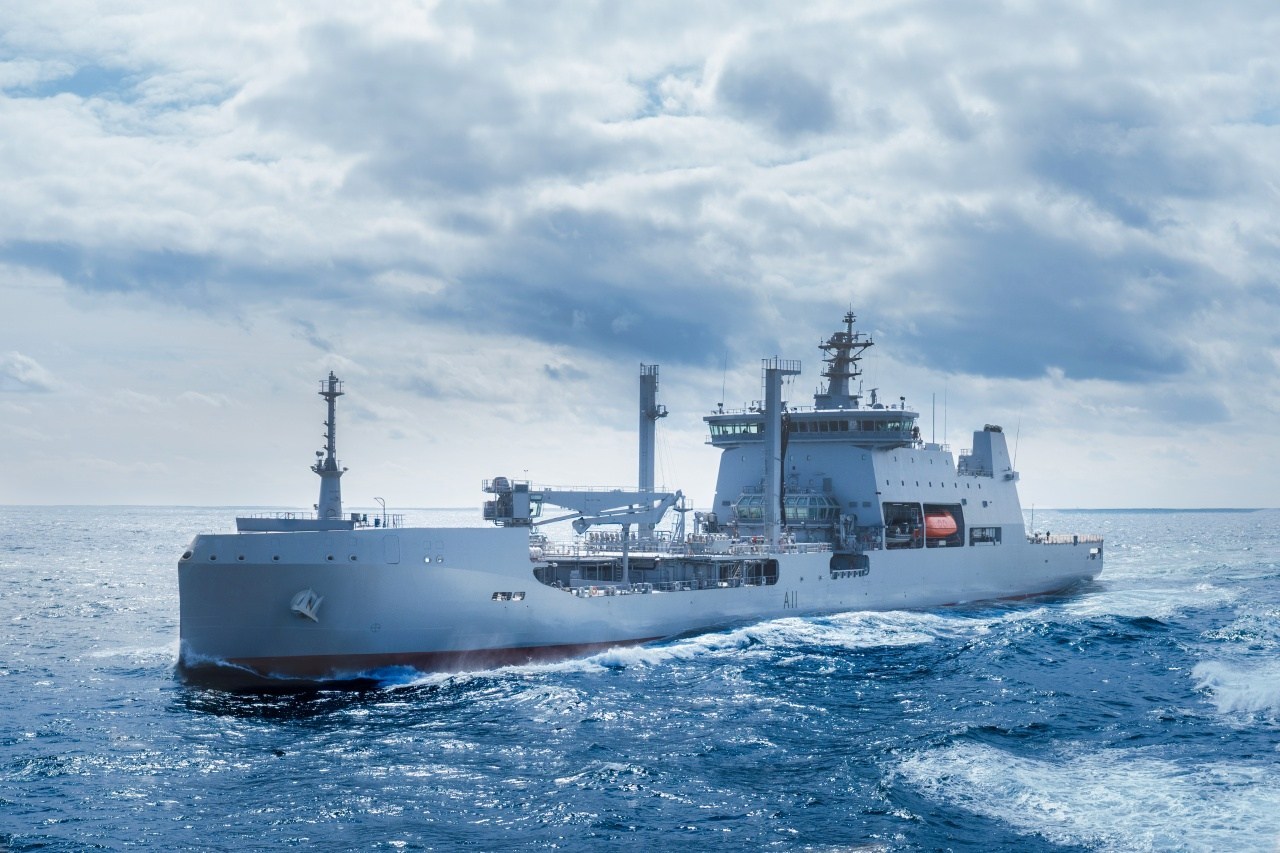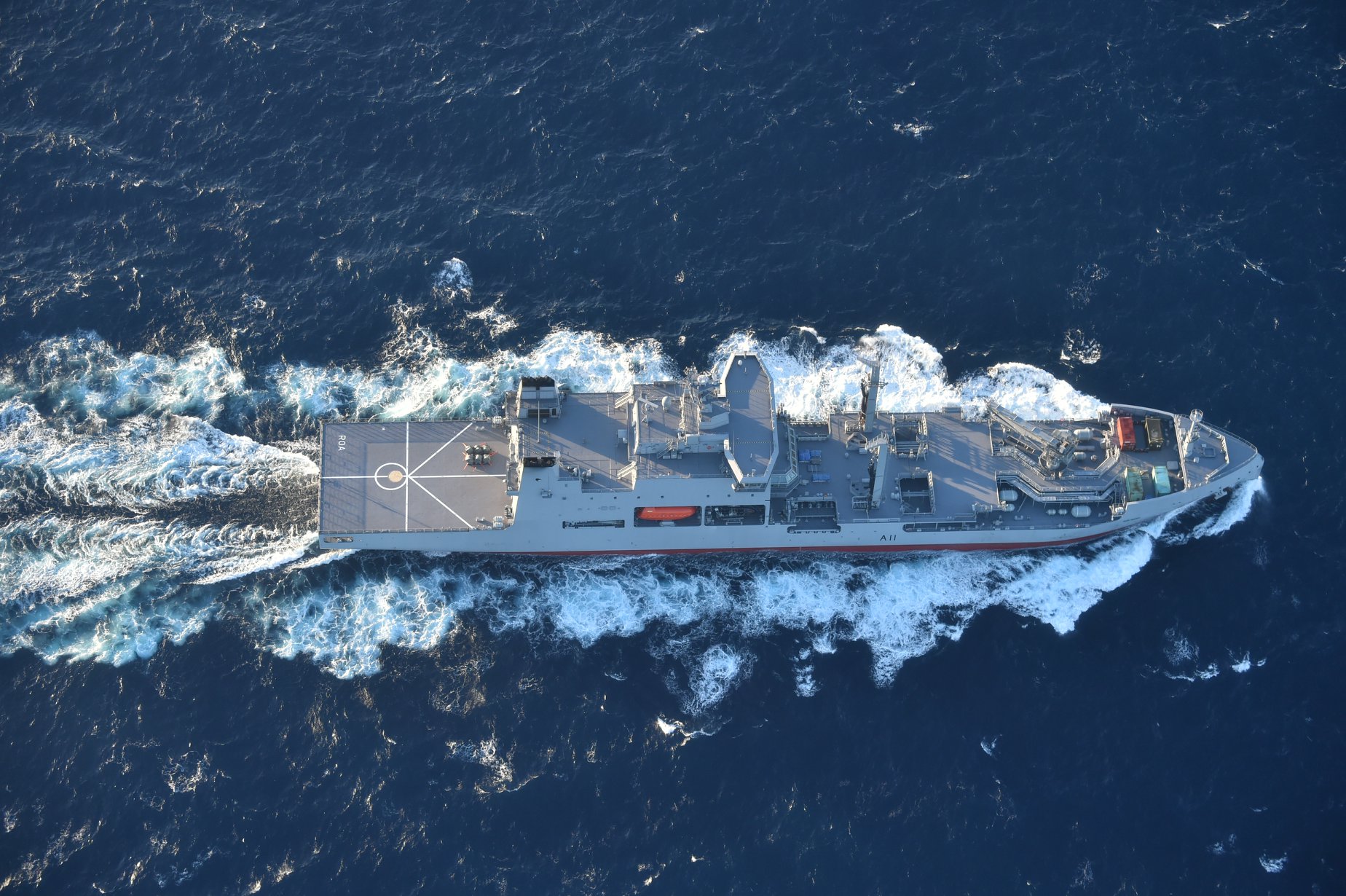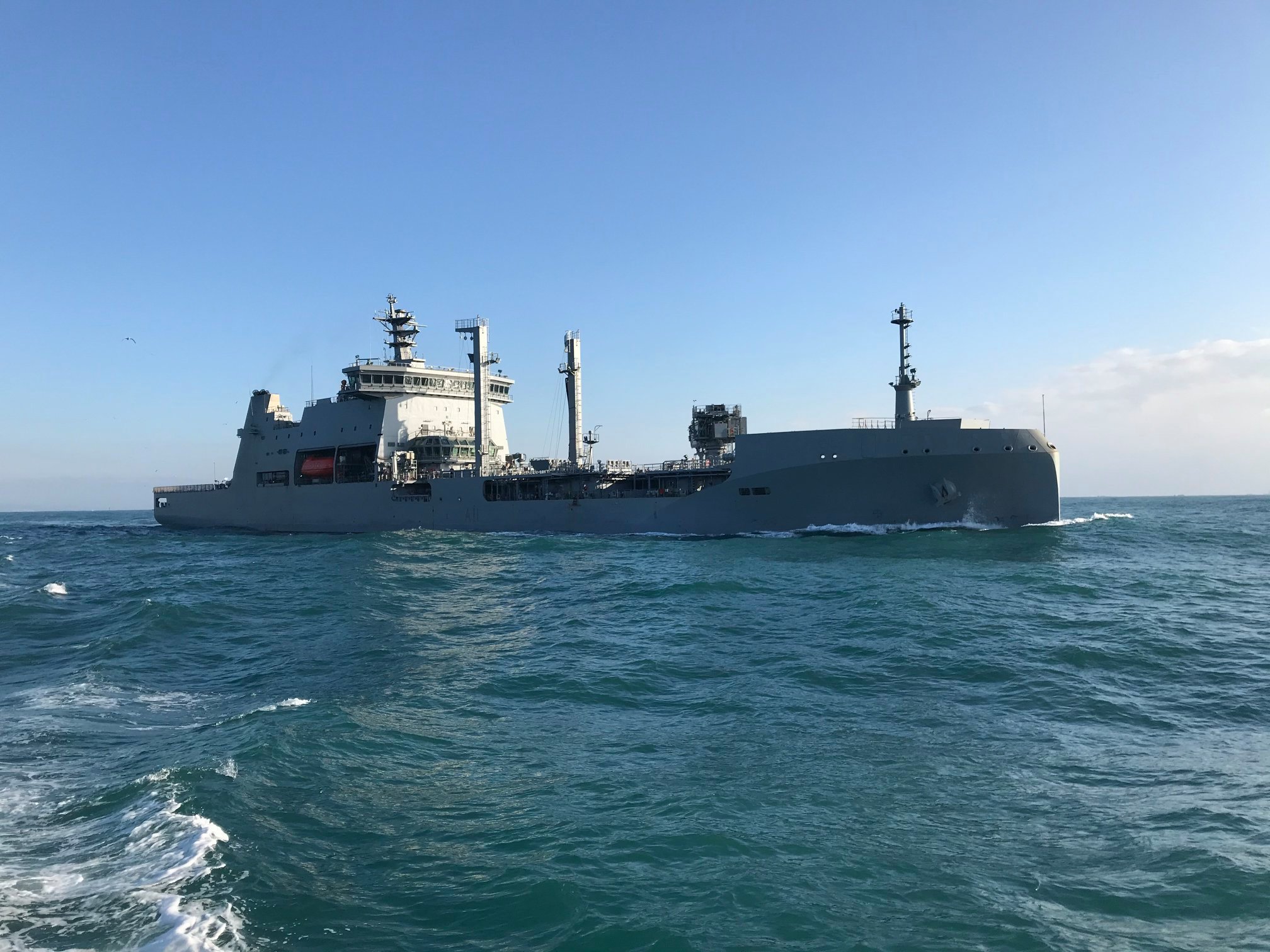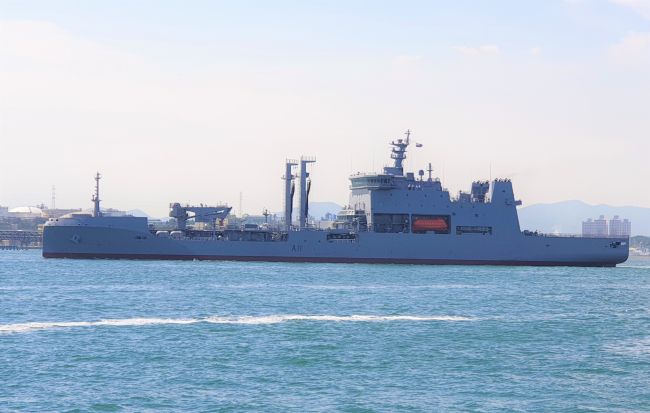On 29 July 2020, after three years of design and build, the Royal New Zealand Navy’s (RNZN) new POLAR class Maritime Projection and Sustainment Capability (MPSC) ship HMNZS AOTEAROA was officially inducted into the RNZN. During the commissioning ceremony, in the presence of the Governor General the Rt Hon Dame Patsy Reddy, RADM David Proctor – the Chief of the Navy, presented Captain Simon Rooke a carved Kauri staff -the Tai-Panuku – the symbol of command, together with the Commissioning Warrant and the Commissioning Pennant. HMNZS AOTEAROA is Captain Rooke’s sixth command in his 30 years of service.
The BACKGROUND
The RNZN’s aspiration to replace the ageing fleet oiler HMNZS ENDEAVOUR with a multi-purpose afloat capability was first promulgated in April 2013. The requirements called for a more versatile ship, capable of contributing to a wide variety of national and international operations while being suited to operate in the Antarctic, as far south as the McMurdo Sounds in the Ross Sea, to resupply the Scott Base during the Summer months (December/March). The MoD approved the programme on 9 July 2014 and a Request for Tender (RfT) for the MPSC-ship was issued on 26 March 2015. Companies responding to the RfT included:
- Damen from the Netherlands
- The South Korean shipyards Daewoo Marine Shipbuilding and Engineering (DSME), teamed with BMT
- Hyundai Heavy Industries (HHI) teamed with Rolls Royce
- Fincantieri from Italy
- Spanish shipyard Navantia
- The Canadian Seaspan Shipyard
- Germany’s ThyssenKrupp Marine Systems.
In December 2015 HHI was downselected as the preferred bidder and, on 18 July 2016, a $NZ 493 million contract was signed. The keel of the new ship was laid at the HHI Shipyard in Ulsan on 13 August 2018 and eight months later, on 24 April 2019, HMNZS AOTEAROA was floated out for outfitting. The coronavirus threw a spanner in the delivery plans though. The supply chain for HHI was affected by a reduced manufacturing and transportation capacity and several suppliers were unable to travel to Ulsan due to international travel restrictions.

Upon completion of the full range of manufacturer, harbour and sea trials, HMNZS AOTEAROA was accepted ‘off contract’ from HHI by the the NZ Ministry of Defence on 8 June 2020 and two days later departed Ulsan for her non-stop transit home. The ship anchored off Rangitoto on 25 June and a day later sailed into Waitematā Harbour where she was welcomed by HMNZS MANAWANUI with the VIPs and media onboard. The New Zealand Government transferred the ownership of HMNZS AOTEAROA to the RNZN on 8 July, followed by her commissioning into the fleet at the end of the same month.
OVERALL DESIGN
Classified as an Auxiliary Oiler Replenishment (AOR), the double-hulled HMNZS AOTEAROA – featuring an axe-bow hull – has a length of 173.2m, a beam of 24.5m, a draught of 8.5m and a full load displacement of 24.678 tonnes[3]. Intended to deploy regularly to the Southern Ocean and Antarctic, she is ice-strengthened to Polar Class 6. To withstand the cold temperatures, the ship received a comprehensive winterisation package, with a cost of $NZ64M (€36.5M), adding some 1600 tonnes to the basic designed displacement, included were:
- A reinforced hull with an increased number of scantlings (ribs of the vessel)
- A higher grade steel plating and extra thickness to counter corrosion and abrasion against ice
- Trace heating of the side ballast tanks, the weather decks and flight deck and the strengthening of equipment subject to ice impact loads, such as the propellers, rudders, main crane and mooring equipment.
Due to the requirement for operations in icy conditions the ship is fitted with two anti-roll stabilisation tanks instead of stabiliser fins and bilge keels because these are too fragile in such an environment.
For transfer of liquid and solid material at sea, HMNZS AOTEAROA has two replenishment/fuelling-at-sea stations, one on each side, capable of delivering marine diesel fuel, aviation fuel and potable water. The ship has a cargo capacity of some 10.000 tonnes of liquid cargo, some 600 tonnes of dry cargo and store up to 22 ISO20” containers on the upper deck. The aft section is the ship is dominated by a 35m x 24.5m flight deck with night landing capability, refuelling and traversing systems. The 16 x 8.5m hanger is suited to operate and maintain a SUPER SEASPRITE SH-2G or NH-90A109 helicopter.
MANAGEMENT SYSTEMS and SENSOR SUITE
The ship features the latest intregrated platform systems, such as the Servowatch Integrated Platform Management System (IPMS). This system incorporates remote control systems and dedicated workstations located in the engine control room and on the bridge, as well as an integrated closed-circuit digital television system, providing video monitoring of the ships’ machinery spaces and other locations around the ship. The Kelvin Hughes Integrated Naval Manta Digital Bridge System (lNBS), including a dual redundant data distribution system, allows the Warship Electronic Chart Display Information System (WECDIS), the Bridge Alert Management System (BAMS) and other networked functions to be operated from any of the designated multifunction displays. The Saab TactiCall Integrated Communications System (ICS) has the full suite of military and civilian communications, including SATCOM, VHF/UHF/HF and GMDSS. The Servowatch Integrated Battle Damage Control System (IBDCS) features a comprehensive range of user interfaces and a fully automatic malfunctions and damage analysis system.

The vessel has been fitted with a large number of automatic detectors and sensor systems as well as CCTVs, ensuring an early warning for any damage occurring in any operational situation. Sensors and detectors distributed throughout the ship provide a flexible, effective approach to data acquisition and control. HMNZS AOTEAROA’s sensor suite includes an Advanced Integrated Multi-sensing Surveillance system with Intelligence, Surveillance & Reconnaissance (AIMS ISR) capabilities and three SharpEye X and S band radars for navigation, aircraft control and surface surveillance and The solid-state SharpEye™ Doppler radars bring full situational awareness to the bridge even in the most severe weather conditions. The ship is also fitted with standard echo sounders, a Farsounder-1000 Obstacle Avoidance Sonar for littoral and ice navigation.
- Navy's largest ever ship finally on its way to New Zealand
- Taranaki brewery creates all New Zealand beer for commissioning of Navy's newest ship
- HENSOLDT UK delivers full Integrated Naval Bridge System for Royal New Zealand Navy ship HMNZS Aotearoa
- Navy charter approved after New Plymouth councillors debate traditional wording
ACCOMODATION
The ship offers accommodation for up to 99 personnel, including a 65-strong core crew and up to 11 flight staff, 14 trainees, an eight strong mission-specific team and a VIP passenger. The core crew is made up of 10 officers, 15 petty officers and 40 ratings. The breakdown by department is 27 in Operations, 14 in the Supply/Support/Medical department and 24 in the Engineering department. Officers, chief petty and petty officers and junior ratings each have their dedicated lounges with a recreational space to relax, watch TV and movies, while Wi-Fi is available throughout all recreation spaces. The ship also features a well-equipped gymnasium and a library. The commanding officer, the heads of department, the chief bosun’s mate and the warrant officer marine technician have their own living/office space, bedroom and private bathroom. The officers, apart from Junior Officers Under Training, have two-berth cabins, while chief petty officers and petty officers enjoy two-or four-berth cabins and ratings four-berth cabins, all with ensuite bathrooms, thus allowing a mix-gender crew. The galley, wardroom and petty officers’ and ratings’ messes are on the same deck.
PROPULSION
The propulsion system is a Combined Diesel Electric and Diesel (CODLAD) configuration, made up of two Rolls Royce Bergen B33:45L9P main diesel engines, supplemented by two electric power take-in motors which draw their power from any two of the four 2.6MW MTU 20V4000M53B generators, driving a two-shaft propulsion system through two 5-bladed controllable pitch propeller (CPPs). This configuration provides a sustained speed of 16 knots and a cruising speed of 12-14 knots and with a range of 6500+ nautical miles. The ship also features a RR Marine(Kongsberg) TT3000 2.5MW CPP tunnel bow thruster and a 410kw STX KTA19DMGE emergency generator.
Interview with CAPTAIN Simon ROOKE
COMMANDING OFFICER HMNZS AOTEAROA

Photo: RNZN
Captain Rooke, you must be very proud to command the RNZN’s newest and biggest ship ever.
When were you appointed her CO ?
Yes, extremely so; in fact we are all very proud of our newest ship. I became the Commanding Officer (CO) designate shortly after the ship’s launch and was formally appointed as CO of HMNZS AOTEAROA by the Chief of Navy at the Commissioning Ceremony on 29 July this year. However since Sep 2019 I have been the CO of NUSHIP[4] AOTEAROA in order to ensure the Ship’s Company had the appropriate command structure while we established and commenced systems training.
What are the most innovative concepts of HMNZS AOTEAROA?
HMNZS AOTEAROA is the world’s first naval ship to adopt Rolls-Royce’s Environship concept design, which includes a new wave-piercing ‘axe bow’ designed hull that optimises the hydrodynamic characteristics and creates less drag and less fuel consumption. The axe-bow shape allows the ship to cut through waves, rather than riding over the top, decreasing resistance by about 8 per cent.
A very innovative and forward thinking aspect is the ‘Environship’ concept that improves the ship’s fuel efficiency, manoeuvrability and stability, as well as reducing CO2 emissions by up to 40 per cent thanks to the Selective Catalytic Reducers. Another design innovation I consider to be significant is the ship’s ability to operate on electric propulsion and loiter at speeds up to 10 kts without using the main engines. And the state-of-the-are platform management systems are definitely new and exciting assets.
How did you and your crew prepare yourselves prior to going onboard ?
Crewing a logistic support ship was not new because about half of my team had served aboard our previous tanker HMNZS ENDEAVOUR. Just under half of my team already had ‘refuelling-at-sea’ experience, having served aboard our previous tanker HMNZS ENDEAVOUR. From mid-2019 we introduced a structured systems training programme, including various courses conducted both in New Zealand and overseas. Crew members undertook RAS training at HMS RALEIGH[‘s] shore based Replenishment Training Facility in the UK, some went to Norway and we have also had various exchanges as part of the RNZN’s ongoing cooperation with partner navies, such as the Royal Australian Navy.

What was on your programme while in Ulsan ?
Throughout the build various personnel travelled to Ulsan as part of the Integrated Project Team (IPT), a team consisting of NZ Ministry of Defence and NZDF personnel. Many transitioned out of the IPT and become part of HMNZS AOTEAROA’s commissioning crew. In addition, at various key times, other members of the prospective crew, in particular the engineers, flew to Ulsan to familiarise with the ship. Prior her acceptance HMNZS AOTEAROA undertook the full range of manufacturer trials, Harbour Acceptance Trials (HAT) and Sea Acceptance Trials (SAT), all of which were observed by the IPT. The results were very pleasing. I was impressed with the way the ship performed at sea.
Part of her ‘at sea’ acceptance trials package saw HHI conductingd a ‘fast back down’ trial for an abeam RAS with the HHI-build Philippine Navy frigate BRP JOSE RIZAL. This station keeping trial assessed the ability for a ship to approach and remain alongside as a confirmation of HMNZS AOTEAROA’s pressure and suction zones during refuelling or replenishment. I saw no issues for the frigate sitting alongside at RAS-distance in a low-medium sea state. We did not yet conducted any actual RAS-serials; these are planned during the first half of 2021.
Did you identify any shortcomings?
As with any new ship, especially a new type of platform for a Navy, there always are minor equipment and design aspects that are identified and then set right during the initial stages of a ship’s life.
- First landing HMNZS Aotearoa welcomed the NZ Air Force
- HMNZS Aotearoa: Covid-19 again scuppers best-laid plans for Navy's big new ship
- Take a 360 tour of HMNZS Aotearoa
- Navy charter approved after New Plymouth councillors debate traditional wording
HMNZS AOTEAROA has a few of these hick-ups, but nothing that I personally consider to be significant, nor unexpected. From my perspective I’ve been pleased with what I have seen so far, and how the ship performed.
Did the COVID-19 pandemic had any impact on the preparation of HMNZS AOTEAROA?
The impact of COVID-19 has been minimal when you put it into perspective. Obviously, there have been some challenges mainly related to international travel restrictions for overseas training courses for the New Zealand-based crew, obtaining and freighting spares from overseas suppliers, but we have been fortunate to work most of these issues through. COVID 19 was factored into her homeward bound passage from Ulsan. Two days before the departure from the HHI Shipyard, Korean health authorities tested the delivery crew, with all testing negative. After a flawless run from Ulsan, without any port visit, and before coming alongside in DNB, we anchored off Auckland and a medical team tested the crew again, with all results coming back negative.
When did you departed Ulsan and what trials were on the programme while on transit ?
We sailed Ulson on 10 June 2020 with a 49-strong delivery crew made up of 38 HHI technicians and 11 RNZN observers, for the direct passage to Auckland, without no port visit underway.
The crossing was relatively benign, with the maximum sea state encountered being Sea State 5 (SS5). No specific trials were conducted although data on steady steaming and endurance figures were a byproduct. The ship has been designed to operate in weather conditions up to Sea State 10 and conduct unrestricted RAS and helicopter operations in Sea State 5. However as the commanding officer my focus is to keep the ship safe before we reach any theoretical limits.

As former CO of HMNZS CANTERBURY, what are the differences in handling HMNZS AOTEAROA?
What are your impressions of her seaworthiness, manoeuvrability and shiphandling so far?
It’s too early to tell as I haven’t taken HMNZS AOTEAROA to sea under my command, but I imagine her size will be the most obvious difference as she is some 40m longer, and over twice the displacement when fully loaded compared to HMNZS CANTERBURY. But from what I have seen already during SATs and our passage home, I am very impressed. The ship feels solid, handles well and has excellent manoeuvrability for a ship of her size. The main differences are the systems fitted to allow operations in the polar environment; for me these are exciting and something new.
Which roles will the ship play within the Royal New Zealand Navy ?
The primary role of HMNZS AOTEAROA is maritime sustainment and support [of] our government’s tasking to deliver maritime security. Obviously, focal point is underway replenishment in order to enhance their endurance. In addition we will regularly deploy to deliver sea training, provide a limited tactical sea lift capacity for disaster relief and humanitarian relief operations, peace support operations, military support activities and development assistance support.
What capabilities does your ship features to comply to these roles ?
HMNZS AOTEAROA mounts two Rolls Royce/Kongsberg replenishment/fuelling-at-sea stations, one on each side, capable of delivering diesel/F76/MGO, aviation fuel and potable water. The rigs are arranged for clear movement of cargo from the stores to the RAS-positions. We can also provide fuel to helicopters either on deck or using Helo In Flight Refuelling (HIFR). She has a liquid cargo capacity of some 8630 tonnes of F-76 marine diesel fuel (enough to ‘fill up’ the RNZN’s frigates HMNZS TE MANA or HMNZS TE KAHA 13 times), 1566 tonnes of aviation fuel, 275 tonnes of water, 300 tonnes of dry bulk cargo and up to 22 ISO 20”TEU containers on deck. The Dangerous Goods container stations are monitored by IPMS and can be plugged-in to the firefighting systems. The ship is also fitted with a Reverse Osmosis plant capable to produce up to 100 tonnes of fresh water a day. A 25-ton SWL crane, located at the forward part, has a 10m outreach. She also features mechanised pelletrons to support moving pallets of cargo while the cargo routes are designed with extra width and flat surfaces. The RAS-parties have a dedicated Ready Room to store their wet gear and prepare for refuelling operations. Although not been specifically designed to act as a command platform, we can embark a small staff. Adjacent the operations room is a planning and a conference room with secure video conferencing facility and our medical facilities allow for NATO Role 1 medical treatment.
Damage control is a very important on a warship. What are your ship’s survival capabilities ?
The ship numbers some 150 compartments and ten water- and gastight bulkheads divide the hull into eleven transverse subdivisions. The ship is divided into two damage control zones with self-sufficient ventilation and five fire zones. The ship is fitted with a Servowatch IBDCS and ship-wide fire detection systems and CCTV cameras. The ship’s DC/FF capabilities include the full suite of RNZN DC/FF equipment made up of fire detection system, automatic temperature-activated sprinklers, automatic extinguishers in the engine rooms and compartments containing critical equipment. Watermist systems fitted to the prime movers, bilge foam sprinklers for engines, and Inergen Firefighting system for the main machinery space. The flight deck and the cargo deck are fitted with Aqueous Film-Forming Foam (AFFF) remotely controlled canons while the hangar has been equipped with foam drenches. For the protection against Chemical, Biological, Radiation and Nuclear (CBRN) agents the ship is equipped with a pre-wetting and sprinkler installations and designed to maintain mobility in a high CBRN-threat level.
Logistic support ships are vulnerable during UNREP evolutions. Is your ship fitted with adequate self-defence capabilities ?
The ship is fitted with an Advanced Integrated Multi-sensing Surveillance system with Intelligence, Surveillance and Reconnaissance (AIMS ISR) capabilities. Depending on the threat level, we will be supported or protected by ships with superior C² and combat capabilities. The ship is currently receiving a ‘RNZN customisation package’ which includes, apart from military communications, IT and security systems, the fitting of two Rafael Mini-TYPHOON Remotely Controlled Weapon Stations (RCWS) with associated IR/Optical surveillance and four 12.7mm machine gun mounts. The forward part of the bow deck is ‘fitted-for-but-not-yet-with’ a Close-In Weapon System (CIWS).
What is on the agenda for 2021 ?
We will continue with our Sea Acceptance Readiness tests including exercises focusing on cargo operations, replenishment-at-sea evolutions with dry and liquid cargo with the upgraded frigate HMNZS TE KAHA, and flying trials including interface trials for NZDF helicopters.
We are also scheduled to deploy to deploys to Australia in early 2021 to have the RAN’s Sea Training Group supporting our RAS-capability tests and during the latter half of 2021 we will start to prepare for our maiden operational deployment to Antarctica in early 2022, during which we will resupply the McMudro and Scott bases.
What do you expect the toughest challenge to bring your crew and ship up to FOC ?
Learning a new ship is always challenging, but I think we will manage that in incremental steps using the experience of our, and our partner navies. In the COVID-19 impacted world, international deployments are likely to look quite different to what we all know and at the moment I see this as the biggest challenge we face.
Biography of Captain Simon Rooke
Captain Rooke, a descended of Admiral Sir George Rooke, who captured Gibraltar for the British Empire, was born in Kawerau and went to Kawerau College and Rotorua Boys’ High before joining the Navy in 1991 as a Midshipman. His seagoing appointments included, amongst others:
- A tour onboard the frigate HMNZS CANTERBURY with a deployment to the Arabian Gulf in 1996 and for which he was appointed as a Member of the New Zealand Order of Merit for his work as the boarding officer.
- A tour onboard the replenishment ship HMNZS ENDEAVOUR (in 1997-99) and again with HMNZS CANTERBURY in 2001.
His first command was HMNZS HINAU during the 2000 America’s Cup Regatta in Auckland. Other seagoing commands include HMNZS Kahu, delivery CO of HMNZ Wellington and CO of HMNZS Otago and later HMNZS CANTERBURY. During the latter, he deployed in support of the tropical cyclone relief efforts in Vanuatu (2015) and Fiji (2016) and the Kaikoura earthquake in 2016. Some of his more important shore-appointments include his assignment, in 2011, as a UN Military Advisor in Kabul, Afghanistan and, upon his return to New Zealand, as the Director of Operations Personnel and Training. Rooke was subsequently appointed as Director of the Ratings Career Management, thus becoming responsible for all RNZN enlisted personnel. Captain Rooke lives in Auckland with his wife Corenna and their two daughters.
Aotearoa is the Maori name for New Zealand
HMNZS ENDEAVOUR was inducted into the navy on 6 April 1988 and decommissioned on 15 December 2017.
Being the RNZN’s largest vessel, the Calliope South Wharf in the Devonport Naval Base, had to be enlarged to accommodate the new ship. The quayside has been extended from 270m to 320m and a new ‘dolphin structure’ installed in order to provide an outboard berth for both HMNZS AOTEAROA and one of the navy’s ANZAC class frigates. New pneumatic fenders have also been fitted to cope with the weight and mass of the ship.




